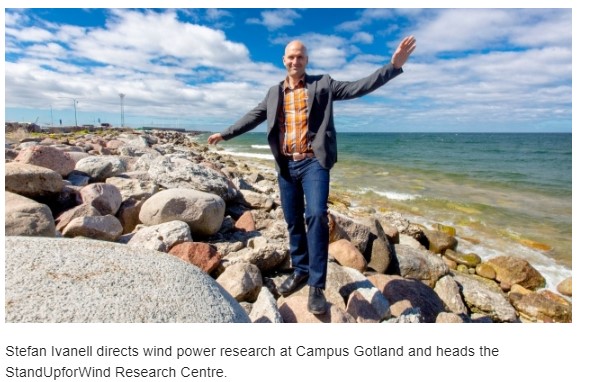Stefan Ivanell, professor in wind energy

Wind power is attracting more and more interest. In Sweden it’s the third largest source of electricity. But research is facing some challenges: How can turbines interact with each other and how do you prevent neighbouring wind power parks from “stealing” energy from each other.
In a wind power park the first row of turbines produce the most energy. Behind them the amount of electricity produced declines dramatically, as pockets of relative calm are formed.
“Our research targets how different turbines interact with each other, and we’re developing models for how to extract energy in a smarter way while also reducing the loads on the turbines so they last longer,” says Senior Lecturer Stefan Ivanell.
He is directing this research at the Division of Wind Power at Campus Gotland, which is now part of the Department of Earth Sciences, Uppsala University.
Performing large-scale computations
While colleagues in Uppsala devise weather models on a large scale, the Visby researchers work with models that show the detailed flows in a wind power park. By linking together these two types of models it’s possible to perform large-scale computations. They are called micromeso-scale computations and can be used, for example, to determine the best site for a wind power park.
“When we study the interaction between wind power parks, these computations take several days or weeks with a supercomputer, so they’re massive computations. This is why we have to complement them with coarser computational methods,” says Stefan Ivanell.
The method is also being used by a major European project, New European Wind Atlas (NEWA), which is tasked with mapping all of Europe’s wind resources. Stefan Ivanell is the project leader for the Swedish part of the project, with SEK 14 million in funding.
More and more interest
Wind power is garnering more and more interest throughout the world, but in Sweden it’s currently at a standstill.
“Right now the price of energy is so low in Sweden that no one’s investing in new production anywhere. But if you’re going to set up new energy production, wind power is extremely competitive,” says Stefan Ivanell.
He is the director of StandUpforWind, a national wind power initiative involving several Swedish universities. In early October a conference called Focus on Wind Power Research will be held in Uppsala.
“We’re working with wind power planning and design from various angles, everything from how wind power can be linked to the grid and balancing the grid to where the wind blows best and how this affects noise levels. Issues of acceptance are also important – how do we deal with people’s resistance? If we do this in the right way, the local population is often very much in favour of wind power.”
Experiments show interaction
A major challenge is the placement of wind power and how the turbines – but also whole wind power parks – interact with each other. To understand this these scientists are carrying out simulations and wind tunnel experiments that show how interaction affects what type of flow the turbine is situated in and how much turbulence there is.
These researchers are collaborating with the industry, with access to real data from wind power parks.
“We use numerical computational models that represent the wind turbines and compare them with real-life parks. If we have the right wind direction, turbulence level and wind speed, we can now compute in considerable detail what it looks like in a park in certain cases, but more research is needed for more advanced cases,” says Stefan Ivanell.
FACTS:
StandUpforWind is a research centre with a profile focusing on designing, planning and establishing wind energy in Sweden, a collaborative effort between the Royal Institute of Technology (KTH) and Uppsala University within the framework of the government’s strategic research area STandUP for Energy. The research centre has a turnover of ca. SEK 40 million for research, education and community outreach and involves some 50 individuals.
The conference Focus on Wind Power Research will be held in Uppsala 6-7 october. The conference is being jointly arranged by StandUpforWind, VindForsk, the Swedish Energy Agency Programme for Cold Climates, SWPTC and Vindval.
